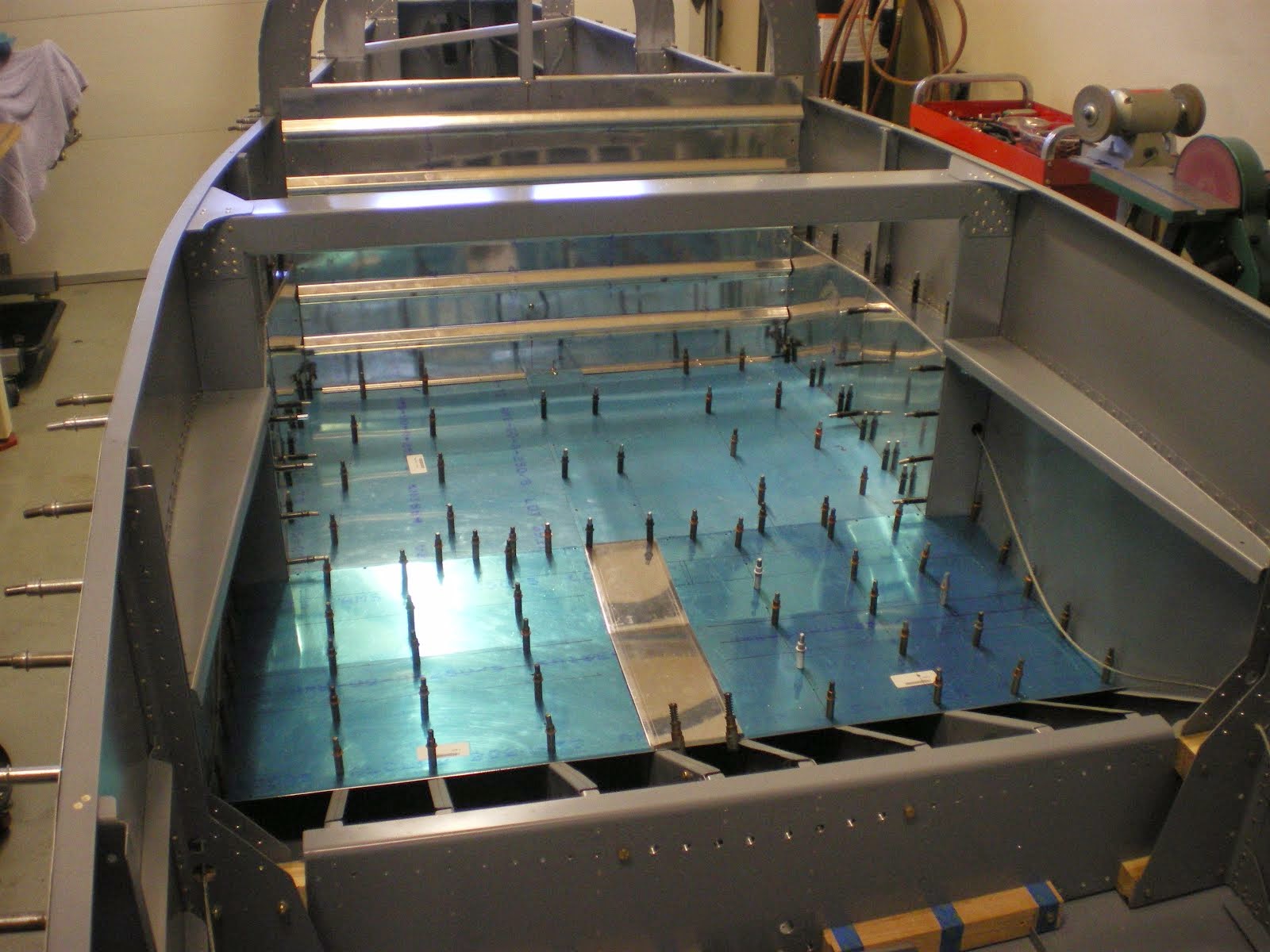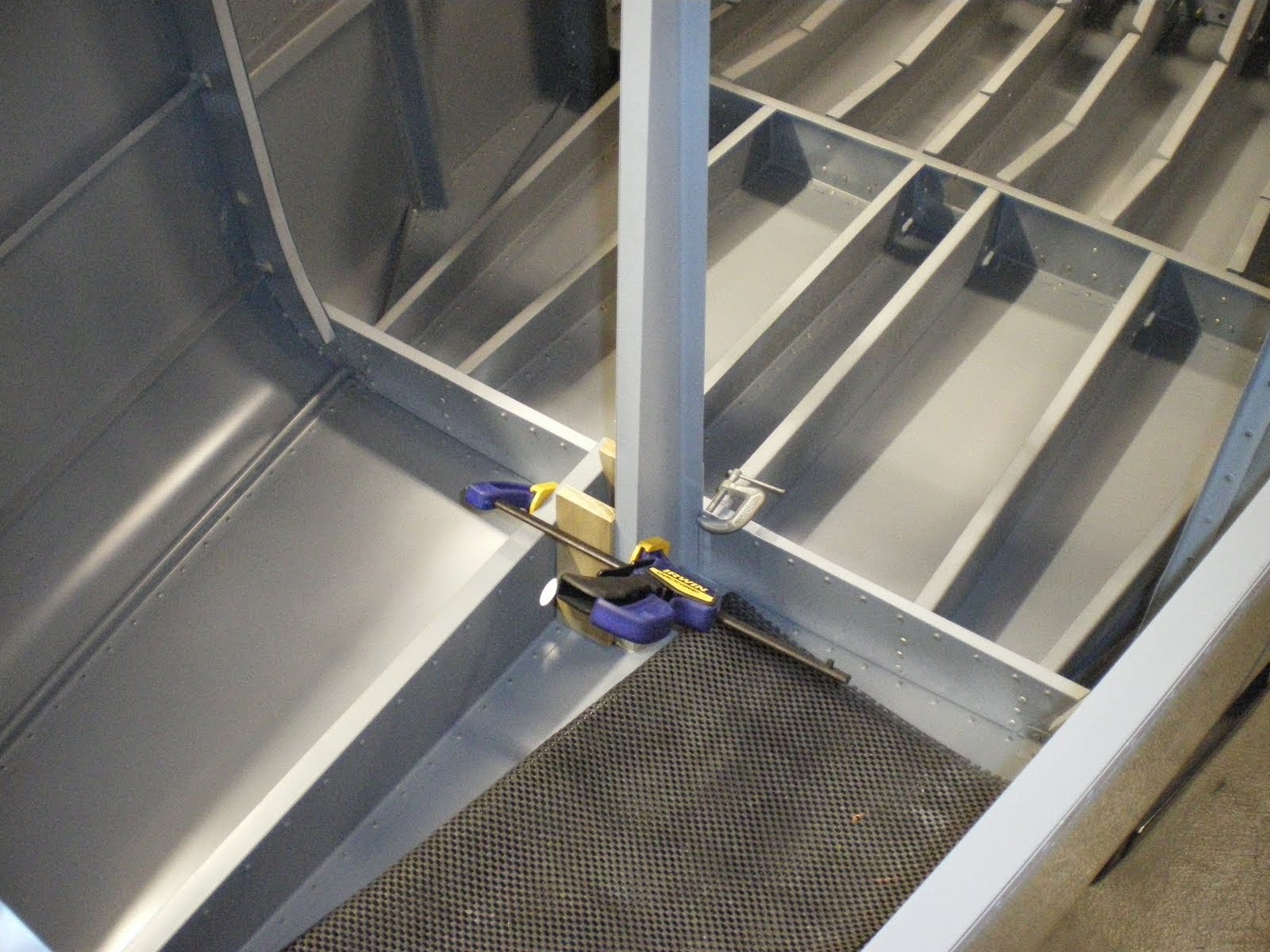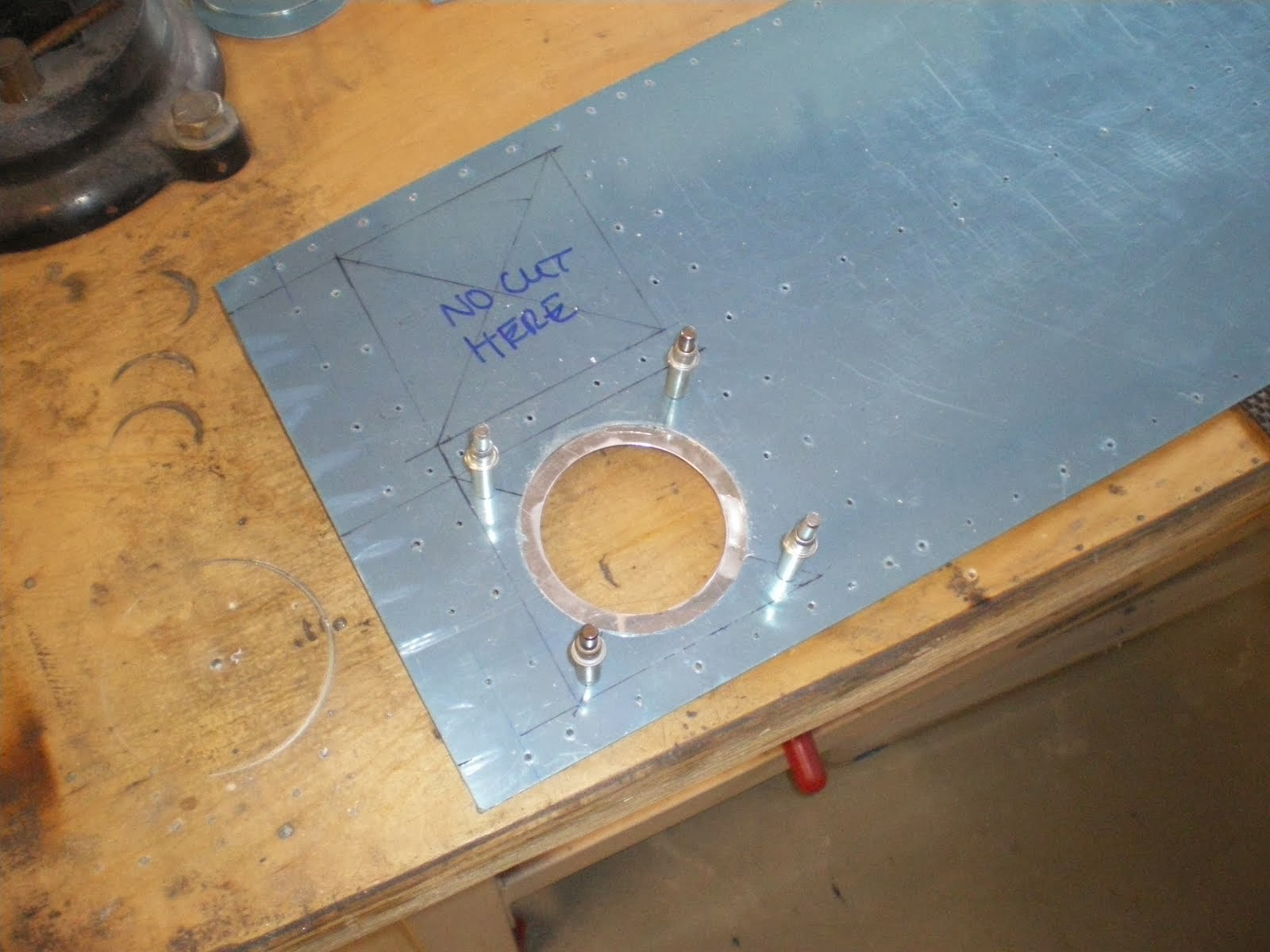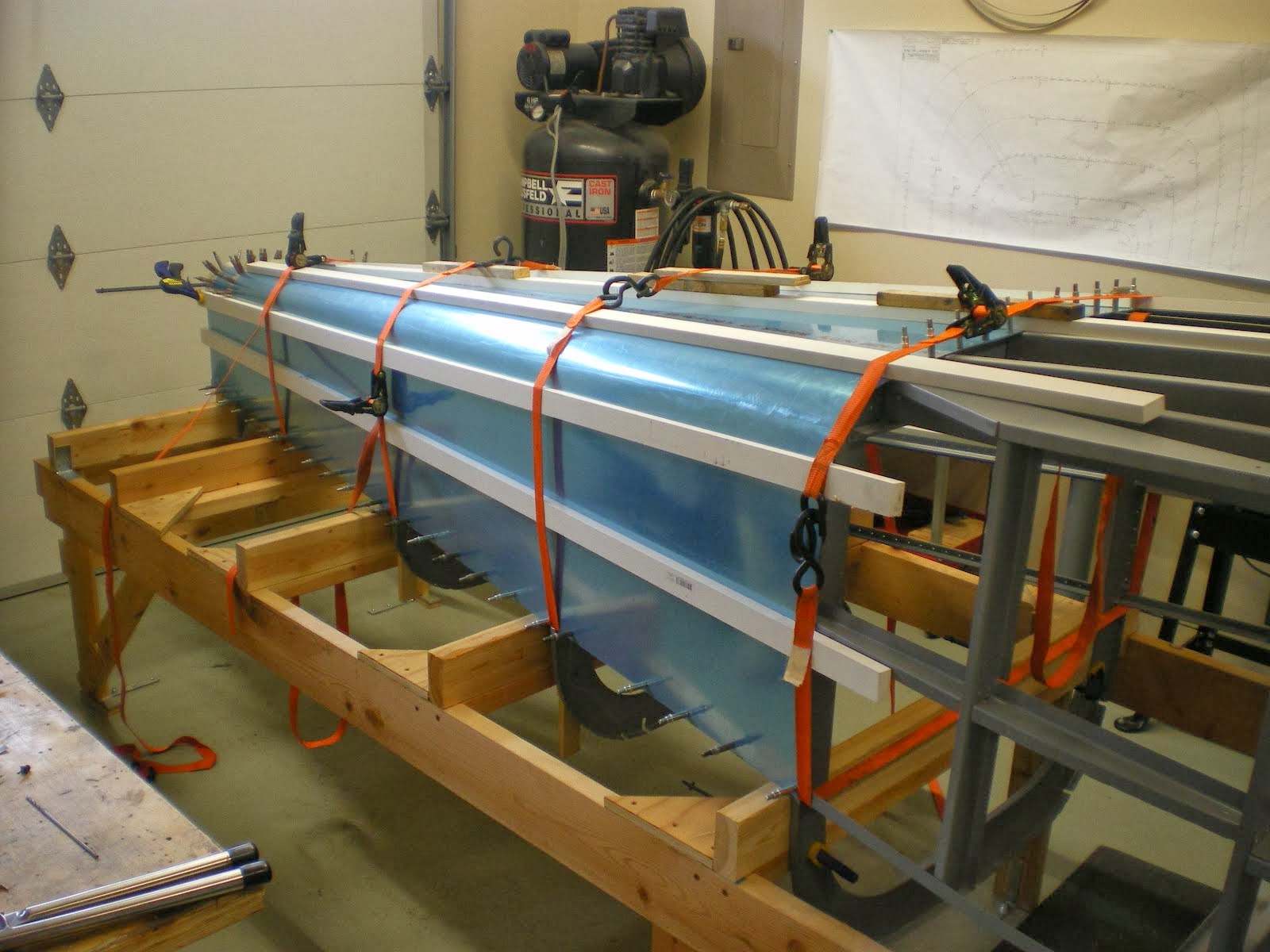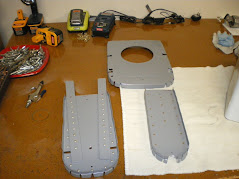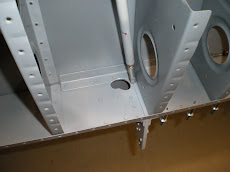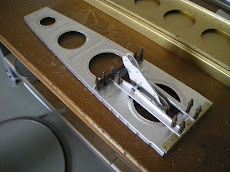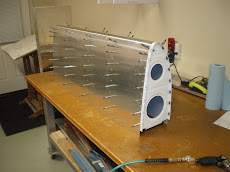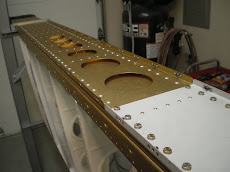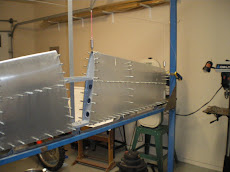It's been a couple of weeks now and I'm still installing parts into this damn fuselage. It seems there are twice as many parts on a RV-6 then a -4.
I have been working on the rear turtledeck stringers, canopy deck, rudder pedal mounts and strobe light mounting plate behind the baggage wall.
What really takes the time is getting all of this stuff to fit just right and look good. The canopy deck has to look good and it right out in front for everyone to see. If you make some mistakes in this area, someone will notice it.
I have etched, alodined and primed all the parts. I went through a primer escapade. I got some OMNI primer from PPG but I'm not really thinking it's all that great. If its a economy primer, it's cheap and not very good. I painted some of the parts with it and they turned out OK. You can scratch the stuff off easily and it doesn't like getting scraped at all. Dupont DTM is WAY better primer and it's a sealer too. Get any solvent around OMNI and it's coming off........
I got some Ful-poxy from Dupont and it's supposed to be very close to DTM but not quite the wallet slam when you go to pay for it. I don't like going cheap in the paint department, however, both PPG and Dupont are putting themselves out of business with their giant price increases every 6 months!!!!
Tuesday, February 3, 2015
Sunday, January 18, 2015
It's just one damn job after another.....part 2
Last couple days I have installed the fuel vents on the bottom of the fuselage. I bought ones from JD air parts and they are all CNC machined with a screen and a secondary vent hole. I put some pins in my to hold the tail end of them when you are torqueing down the vent with the AN fitting. I cut some drill bits off to be my pins and I drilled slightly undersized holes in the tail end of the vent. Then I pressed in the pins. I then drilled my vent hole and then aligned the vent body to be aligned with the centerline of the aircraft. Once I found my centers, I drilled the #40 hole in the spot for the pin. This will keep the body of the vent from turning and not being in trail with the air.
Today I worked on the top canopy deck for the right side. I had to cut the areas out to fit around the centersection and the rear area to fit around the seat bulkhead. Then you have to contour the edge of the deck to the side of fuselage skin so it does not overhang. This was a lot of filing.......to get it just right. I got that fitting real nicely so I fitted the front deck and I went back and counter sunk all of the holes in the top deck. It's ready to be etched and primed.
I also worked on the rear fuselage turtledeck stringers. Getting those lined up and drilled. I am using a piece of .063 angle on the top stringers instead of the J-strips. I don't like those things and I think they are cheesy. I will have to shim a lot more using the angle but I will get a nice smooth riveting job. I'll be glad when the top turtledeck is on and I can start mounting the tail.
Today I worked on the top canopy deck for the right side. I had to cut the areas out to fit around the centersection and the rear area to fit around the seat bulkhead. Then you have to contour the edge of the deck to the side of fuselage skin so it does not overhang. This was a lot of filing.......to get it just right. I got that fitting real nicely so I fitted the front deck and I went back and counter sunk all of the holes in the top deck. It's ready to be etched and primed.
I also worked on the rear fuselage turtledeck stringers. Getting those lined up and drilled. I am using a piece of .063 angle on the top stringers instead of the J-strips. I don't like those things and I think they are cheesy. I will have to shim a lot more using the angle but I will get a nice smooth riveting job. I'll be glad when the top turtledeck is on and I can start mounting the tail.
Sunday, January 11, 2015
It's one damn job after another........
In the past few weeks I have been working on getting the cockpit floorboards installed in the plane.
There is quite a few nutplates to install in the cockpit with all the panels that need to be removed for inspections. I wanted to get the floorboards and side panels done before I went back to the tail and finished up the turtle. There is a lot of work in the baggage area and it's a lot easier to get in there without the turtledeck skins on.
On the last RV-6, I worked from the inside and was constantly climbing in and out of the plane. It was hard work kneeling down and trying to get at everything. Over the years I have learned to work smarted, not harder. This stems from experience.
With the fuselage open and set at the correct height, you can simple lean over the reach almost anything you need to get at.
The baggage compartment panels were all fabricated by me. Vans does not provide the correct panels. I don't know what people do with the ones supplied in the kit but they just don't fit. I have to make them for the first RV-6. After I got those done, I made the baggage floor boards, then the seat pans and seat backs. Then the last part was to make the stick covers. These are tricky since they have to fit around the centersection. Getting a good fitment is critical because air will blow in from the wings and blow around your legs. In cold weather, you will find out where you did not get a good fit and the spaces will blow out ice cold air. On this plane, I got a excellent fit and I'm really happy.
I spent a better part of the week just putting in nutplates. Then I had to get paint since I ran out of primer. I am using OMNI primer and urethane paint. I went to get some PPG DCC single stage Concept paint and they wanted 232.00 a quart!!! Uh, no thanks.......
I had the paint store match the old color than was in the first RV-6. Northwest Orient Gray (33131) and then I add 30g of black toner to each quart. This gives me a nice light gray that hides lots of imperfection in the parts. I sprayed the seat belt brackets with the Urethane since they have to be bolted in before you pop rivet the floorboards in place.
I also installed the soundproofing in the bottom of the cockpit. This helps keep sound and vibration (from the exhaust) out of the cockpit. It also helps insulate the cockpit too. I bought some double sided soundproofing from JEGS. I cut the fabric to size for each bay and then I seal the edging of each piece with aluminum tape. This keeps the moisture from getting in the felting. It takes a while to get all of this done. I sprayed the bottom each bay again with primer to seal it off and cover the rivets with primer. I don't want any of the adhesive touching aluminum. I used 3M Super 77 spray to glue the pieces down to the bottom of the fuselage skin.
I spent about a week just etching, alodining and priming pieces...........
Now I am starting back in the tailcone again to finish the strobe light power pack mounting plate. It's the same as the ELT plate except it's for the right side.
There is quite a few nutplates to install in the cockpit with all the panels that need to be removed for inspections. I wanted to get the floorboards and side panels done before I went back to the tail and finished up the turtle. There is a lot of work in the baggage area and it's a lot easier to get in there without the turtledeck skins on.
On the last RV-6, I worked from the inside and was constantly climbing in and out of the plane. It was hard work kneeling down and trying to get at everything. Over the years I have learned to work smarted, not harder. This stems from experience.
With the fuselage open and set at the correct height, you can simple lean over the reach almost anything you need to get at.
The baggage compartment panels were all fabricated by me. Vans does not provide the correct panels. I don't know what people do with the ones supplied in the kit but they just don't fit. I have to make them for the first RV-6. After I got those done, I made the baggage floor boards, then the seat pans and seat backs. Then the last part was to make the stick covers. These are tricky since they have to fit around the centersection. Getting a good fitment is critical because air will blow in from the wings and blow around your legs. In cold weather, you will find out where you did not get a good fit and the spaces will blow out ice cold air. On this plane, I got a excellent fit and I'm really happy.
I spent a better part of the week just putting in nutplates. Then I had to get paint since I ran out of primer. I am using OMNI primer and urethane paint. I went to get some PPG DCC single stage Concept paint and they wanted 232.00 a quart!!! Uh, no thanks.......
I had the paint store match the old color than was in the first RV-6. Northwest Orient Gray (33131) and then I add 30g of black toner to each quart. This gives me a nice light gray that hides lots of imperfection in the parts. I sprayed the seat belt brackets with the Urethane since they have to be bolted in before you pop rivet the floorboards in place.
I also installed the soundproofing in the bottom of the cockpit. This helps keep sound and vibration (from the exhaust) out of the cockpit. It also helps insulate the cockpit too. I bought some double sided soundproofing from JEGS. I cut the fabric to size for each bay and then I seal the edging of each piece with aluminum tape. This keeps the moisture from getting in the felting. It takes a while to get all of this done. I sprayed the bottom each bay again with primer to seal it off and cover the rivets with primer. I don't want any of the adhesive touching aluminum. I used 3M Super 77 spray to glue the pieces down to the bottom of the fuselage skin.
I spent about a week just etching, alodining and priming pieces...........
Now I am starting back in the tailcone again to finish the strobe light power pack mounting plate. It's the same as the ELT plate except it's for the right side.
Subscribe to:
Posts (Atom)






















